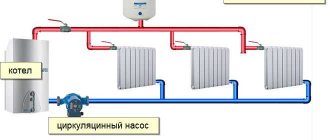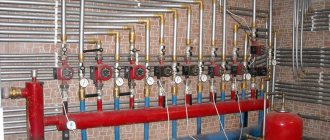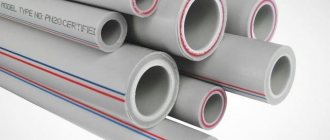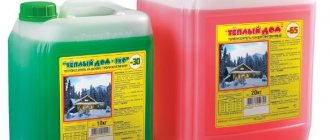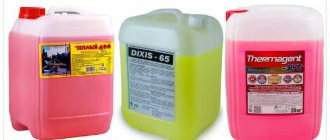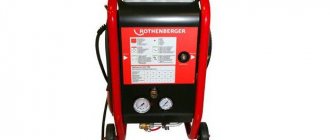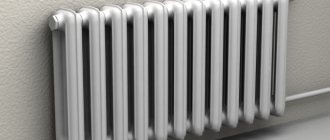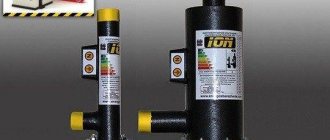In what cases should antifreeze not be used?
Why is the question posed this way? Everything is very simple - you can easily familiarize yourself with the specific positive qualities of any brand of antifreeze. Such information is actively distributed by manufacturers. For our part, we want to present those features of this technical fluid that they are trying to keep silent about:
- Antifreeze cannot be used in double-circuit boilers - it is possible to mix coolant from the heating circuit into the water supply circuit. As is known, non-freezing liquid is poisonous due to its physical and chemical properties.
- It also cannot be used in open systems - evaporation of the coolant is possible.
- It is unacceptable to use antifreeze in a system with a galvanized pipeline - it is fraught with chemical changes and loss of its original properties.
- The heat capacity of non-freezing liquid is lower than that of water, which means that radiator batteries of higher power will be required.
- The viscosity of antifreeze is also higher - more powerful circulation pumps are needed.
The container for antifreeze must be of sufficient volume and correctly calculated according to the project
Properties of non-freezing liquid, which lead to an increase in the cost of the heating system
- Increased viscosity. The viscosity of antifreeze-based coolant is 3-5 times higher than that of water. Therefore, the performance of the circulation pump should be 10-15% more.
- Low heat capacity. The heat capacity of antifreeze can be up to 15% lower than that of water; this should be remembered when choosing heating devices. Radiators or other heating devices should be 15-20% more powerful.
- High turnover. This property of antifreeze places increased demands on the installation of the heating system. If possible, make as few connections as possible to reduce the risk of leaks. For example, if you plan to use a homemade distribution manifold in the heating system, then it is recommended to use polypropylene tees for its assembly. High-quality soldering virtually eliminates leakage of such a collector. On the contrary, it is not recommended to make a manifold from steel tees connected by nipples; a large number of connections increases the likelihood of leakage. As a last resort, all manifold connections can be sealed with anaerobic sealant. Also a prerequisite in the case of using antifreeze is to carry out a pressure test of the system.
Homemade distribution manifold made of polypropylene tees.
Thus, the use of antifreeze for the heating system of a country house leads to an increase in its cost, because it is necessary to install radiators with a larger number of sections, as well as a more efficient circulation pump.
Note! In addition to all of the above, it is always necessary to have an additional supply of antifreeze in case the heating system fails, when part of the coolant has to be drained to carry out repair work.
When producing high-quality coolants, special additives are added to the liquid, which protect the system from corrosion and scale, and also reduce the formation of microbubbles.
Propylene glycol antifreeze
Propylene glycol in the heating system is not as toxic as the previous type. Such antifreeze may contain food additives that are not even dangerous to human health.
True, such a coolant may contain various additives that can affect the materials from which various elements of the heating system are made. How additives work depends on the material from which the heating system components are made. Some additives are needed to prevent various oxidation or foam formations from occurring inside the heating system.
Propylene glycol antifreeze
Comparison of technical and operational parameters of heating antifreezes and water
It is worth pointing out that anti-freezing for the heating system is not the only option for solving the problem of possible freezing of the pipeline and boiler in the event of an emergency, namely a lack of electricity or a cessation of fuel supply in the form of gas.
The way out of the first situation is to use spare gasoline generators; if there is no gas, purchase a boiler with two types of fuel in advance.
That is, any user is faced with a choice - to use ordinary water with various methods of insurance against freezing or to use antifreeze. In any case, it is useful for him to have the following comparative information of these two types of coolants:
Availability. You can always get clean water by turning on the tap in your house or drawing it from a well or borehole. Antifreeze must be purchased in a retail chain, wasting time, paying for transportation costs or delivery.
Features when starting the heating system
Different compositions of solutions affect the operation of the heating system. Thus, the presence of ethylene glycol affects the initial stage of system startup. The heating process must be started at low power, then gradually increased to the required level. This method will reduce the toxic effects of this substance.
A product based on propylene glycol does not require such adjustments when starting heating equipment.
When all the requirements are met, then there is no need to be afraid of using “anti-freeze” as a coolant. It will solve a lot of problems if used skillfully.
Prices for non-freezing liquid vary, and so does the quality. The policy here should be this: when it is not possible to buy a good product, it is better to stick with water. In this case, you must ensure that the coolant is drained from the system before the onset of frost, or turn on the heating devices on time.
What kind of anti-freeze liquid should I pour into the heating system?
To summarize, you can determine which antifreeze liquid to pour into the heating system. If you have definitely decided that you will be pouring anti-freeze into the circuit, then it is better to opt for propylene glycol or glycerin compositions. The former are more expensive, while the latter have insignificantly lower thermal conductivity and greater weight. Considering the fact that propylene glycol antifreezes are the most modern, many consumers choose them. It is better not to deal with ethylene glycol compounds, since the likelihood of contact with a person is quite high, and servicing a circuit with a toxic substance is quite problematic.
Other components
Recipes for factory-made antifreeze liquids necessarily contain surfactants. They are designed to remove dirt, soot, grime, oil and anything else that may limit visibility from the glass surface.
For a liquid to be effective in cleaning glass, very few surfactants are required. Flavorings are also used in the production process. They serve to give the product a pleasant smell. Manufacturers often use the scent of apples, citrus fruits or any other product with a persistent and “tasty” aroma. Dyes color liquids in different colors. This makes it easier for the buyer to identify the desired product. Separately, it is necessary to say about water. For the manufacture of the highest class products, distilled is best suited. In some cases, it is possible to use artesian water with a minimum of salts. But the most ordinary one (from the tap) is not suitable for making anti-freeze.
What problems does heating fluid solve?
Inhibitors have been added to the antifreeze liquid for water heating, which solve a number of problems. High-quality antifreeze that complies with GOST must perform the following tasks:
- promote unhindered circulation of liquid to release maximum heat in a short amount of time;
- should not cause corrosion of equipment;
- eliminate the appearance of deposits and plaques;
- be resistant to foaming;
- have a high level of security.
In this case, antifreeze is used in conditions of high temperatures and high pressure
This is why it is so important to carefully select an anti-freeze solution for the heating system of a private home. This will avoid costly repairs to the heating system.
If you take anti-freeze, what brand?
Liquids for heating systems
Today's market offers varied offerings of these specific products.
However, there are also leaders here. Heating fluid called “Warm Home” is in great demand among consumers. This product is produced in Russia.
“Warm House” has been successfully used for many years, so we can confidently say that the liquid has stood the test of time. And this antifreeze is best characterized by reviews from homeowners who have considerable experience in operating heating systems using antifreeze liquid.
According to them, this brand does not lose its characteristics over ten heating seasons.
This fully corresponds to the service life declared by the manufacturer. As you know, reviews from satisfied consumers are the best proof of quality.
Also popular are brands such as Energos Universal, Energos Lux, Thermagent, Dixis, etc.
Russian manufacturers produce antifreezes based on ethylene glycol in two versions: with a freezing temperature of up to -30°C, and also with a freezing temperature of up to -65°C.
The above-mentioned manufacturers are actively expanding their range of non-freezing coolants made from food-grade propylene glycol, an environmentally friendly raw material. And this is not in vain, because the demand for heating antifreeze is growing, which means there must be supply.
Cases in which the use of antifreeze is strictly prohibited
When not to use antifreeze
It is not difficult to familiarize yourself with all the advantages of antifreeze from any manufacturer.
This information is actively advertised by brands. On the other hand, we should talk about the features of this liquid, which manufacturers try not to emphasize:
- It is prohibited to use antifreeze in double-circuit boilers. After all, the design features of this heating system are such that coolant can leak from the heating duct into the water supply circuit. And due to its chemical properties, the non-freezing liquid is poisonous.
- It is strictly forbidden to use antifreeze in open systems; in this case, it may evaporate.
- Also, antifreeze should not be used in heating systems with galvanized pipelines. When interacting with them, loss of original properties and chemical changes are possible. It is not recommended to pour antifreeze into cast iron boilers. At the very least, you need to make sure that your unit contains paronite gaskets that can prevent the harmful effects of antifreeze. The technical data sheet of the product will help you with this.
- The heat capacity of antifreeze is lower than water, as a result, radiator batteries of higher power are needed.
- Since the viscosity of the non-freezing liquid is higher, more powerful circulation pumps will be required.
In any case, the final decision is always yours. It is impossible to say for sure which is better, water or non-freezing liquid.
It all depends on individual heating parameters. Before making a final decision on the choice of a particular coolant, you should seek advice from specialists.
Antifreeze for heating
In addition to water, special non-freezing liquids - antifreeze - are poured into heating systems. Usually these are aqueous solutions of polyhydric alcohols. Not so long ago, glycerin-based antifreeze appeared on our market. So now there are three types of non-freezing liquids for heating systems.
Types of non-freezing liquids and their properties
Antifreezes are based on two substances: ethylene glycol and propylene glycol. The first is cheaper, freezes at lower temperatures, but is very toxic. You can get poisoned not only by drinking, but even by simply getting your hands wet or inhaling fumes. The second non-freezing coolant for the heating system is based on propylene glycol. It is more expensive, but safe. Sometimes it is even used as a dietary supplement. Its disadvantage (besides the price) is that it loses fluidity at higher temperatures than propylene glycol.
Ethylene glycol coolant is very toxic
Despite their high toxicity, ethylene glycol coolants are more often purchased. This is most likely due to the price - propylene glycol is twice as expensive. But ethylene glycol antifreeze in its pure form is also chemically active, can foam, and has increased fluidity. Foam and activity are combated with additives, and increased fluidity is not corrected in any way. Paired with toxicity, it is a dangerous combination. If there is the slightest possibility somewhere, this antifreeze will leak. And since its vapors are poisonous, this will not lead to anything good. Therefore, if possible, use propylene glycol.
Another important drawback is that ethylene glycol reacts very poorly to overheating, and overheating occurs at a fairly low temperature. Already at +70°C, a large amount of sediment is formed, which settles on the elements of the heating system. Deposits reduce heat transfer, which again leads to overheating. In this regard, such antifreezes are not used in systems with solid fuel boilers.
Propylene glycol, on the contrary, is chemically almost neutral. It reacts less than other coolants with other substances; overheating occurs at higher temperatures and does not lead to the same consequences.
Propylene glycol coolant is safe. but costs more and freezes at higher temperatures
Features of systems with antifreeze as a coolant
When designing a heating system, the coolant must initially be taken into account. This is due to the lower heat capacity of non-freezing liquids, as well as their other properties
If all the equipment was designed for water, and antifreeze is poured into it, the following problems may arise:
- There won't be enough power and the house will be cold. This is due to the lower thermal conductivity of antifreeze. This problem can be solved with little effort - increase the speed of the coolant by installing a more powerful circulation pump. But in an amicable way, an increase in the number of radiator sections is required.
- In closed systems, the volume of the expansion tank may be insufficient. This is due to the fact that when heated, antifreezes expand more than water. The solution is to install another tank. The total volume should be slightly larger than required (the volume can be taken from the table).
Expansion tank volume for different types of coolant
If regular rubber gaskets are used, if ethylene glycol or glycerin is used, they will break down and leak after a short time. Therefore, before adding antifreeze, the gaskets in all detachable connections are replaced with paronite or Teflon ones.
As you understand, the best coolant for a heating system is water. It has better characteristics and is several times cheaper. If the heating is in danger of defrosting, you have to fill in antifreeze, but not for automobiles, but special ones for heating. In this case, if you have enough funds, it is better to use propylene glycol. Ethylene antifreezes are a last resort. They are suitable in closed systems, in which special gaskets and automated boilers are installed that will prevent overheating.
To make it easier for customers to navigate, dyes are added to coolants. Ethylene ones are red or pink, propylene ones are green, glycerin ones are blue. After some time, the color may become less intense or disappear completely. This occurs due to thermal destruction of dyes, but does not affect the properties of the antifreeze itself.
Antifreeze classification
There are many types of these products on the market. Antifreeze liquid for heating boilers can be made based on an aqueous solution of glycerin, ethylene glycol, propylene glycol, and so on. Since all substances are highly aggressive, the liquids contain special additives.
Each type has certain specific characteristics:
- Ethylene glycol-based liquid is common among buyers because it has the most affordable price. But it is the most toxic and cannot be used for double-circuit boilers. May pose a health hazard if released into water supplies. If the boiling point rises above 110 degrees, the substance may produce a precipitate that can stop the operation of a number of system elements;
- from propylene glycol - the properties of the composition are almost similar to the previous one, but it is less harmful and safer;
- based on glycerin - environmentally friendly antifreeze, non-toxic, protects the system from corrosion. When it turns into a solid state, it does not increase its volume, and in order for the system to start, it just needs to be warmed up;
- from a natural bischofite solution - has a high level of heat transfer and heat capacity, the freezing point is low and the boiling point is high;
- salt carriers - are produced on the basis of solutions of sodium, calcium and other mineral salts. They have high corrosiveness to pipes.
Antifreeze base
Various substances can be used as a basis for the manufacture of antifreeze. The most common are ethylene glycol, propylene glycol, glycerin and alcohol.
Ethylene glycol based coolant
Today, ethylene glycol-based antifreeze is the most common non-freezing coolant used in heating systems of private homes. However, it is quickly being replaced by more advanced and environmentally friendly propylene glycol antifreeze.
Ethylene glycol reliably protects the system from freezing. When the freezing temperature is exceeded, the coolant expands by 1.5-2%, which is not enough to cause a rupture in any part of the system.
Important! It must be remembered that ethylene glycol-based coolant is poisonous and can pose a danger to human health and life. During operation, it is recommended to completely exclude its contact with humans. In particular, this applies to heating systems with natural circulation, which have
open expansion tank
. An open-type tank must be installed in the attic, but not in a living space. As a last resort, you should make a gas outlet pipe from the tank, which will discharge dangerous fumes to the street.
When working with ethylene glycol, precautions must be taken, in particular wearing goggles and rubber gloves. Ethylene glycol can penetrate the human body through the skin, therefore, if during repair work or filling the system the antifreeze liquid gets on the skin, you should immediately wash it off with warm water and soap. If ingested, rinse the stomach and immediately go to the hospital or call an ambulance. It must be remembered that a 100-200 ml dose of ethylene glycol-based antifreeze entering the human body can be fatal. Lethargy and depression are obvious symptoms indicating poisoning.
Hot Stream, 20 kg - concentrated antifreeze for the heating system of a country house.
Ethylene glycol is not recommended for use with double-circuit boilers, because Antifreeze may enter the hot water supply circuit.
Storage should be carried out in a tightly closed container away from direct sunlight, electrical heating devices and food. It is highly not recommended to use ethylene glycol-based coolant in heating systems of houses where small children live, because the liquid has a sweetish taste and does not have an unpleasant odor, so small children will not be able to determine that it is poison, but on the contrary, they may think that it is some kind of juice or just sweet water!
Important! If a coolant leak occurs, then all objects on which ethylene glycol has fallen or been absorbed (tiles, linoleum, parquet, furniture,
decorative radiator screens
etc.) must be subject to mandatory replacement. Otherwise, they will be a constant source of toxic fumes.
Spent ethylene glycol antifreeze must be processed at specialized enterprises; it is prohibited to discharge it into sewers or soil.
Propylene glycol based coolant
Due to its relative harmlessness, antifreeze based on propylene glycol is used in facilities with high environmental requirements, where there is a possibility of the coolant getting into tap water or other human objects. As noted above, propylene glycol antifreezes, despite their higher cost, are gradually replacing non-environmental ethylene glycol antifreezes.
Propylene glycol antifreeze has been used as a coolant for heating systems since the 60s of the last century. However, only from the mid-90s, Western European countries, the USA and Canada began to completely switch to propylene glycol. Currently, Russia is also gradually switching to this safe antifreeze.
The coolant based on propylene glycol has a high viscosity, which nevertheless does not affect the hydraulic characteristics of the heating system. The fact is that propylene glycol has “lubricating properties” that compensate for its high viscosity.
The density of propylene glycol coolant is lower than the density of ethylene glycol, which reduces the load on the circulation pump and also ensures more efficient circulation of liquid through the heating system.
In addition, if propylene glycol-based antifreeze leaks, there is no need to replace all “contaminated” items. It is enough just to remove the coolant from the surface of objects and wipe them with a wet cloth.
Compared to ethylene glycol, propylene glycol more reliably protects the heating system from defrosting. Even if the minimum temperature is exceeded, propylene glycol antifreeze does not freeze, but turns into a mushy liquid, expanding by only 0.1%. With such a volume of expansion, rupture of the system is impossible.
The only drawback of this antifreeze is its high cost.
Hot Stream, 10 kg. The temperature at which crystallization begins is -30°C. Ingredients: ethylene glycol, demineralized water, Arteco additive package (Belgium). .
Glycerin based coolant
Glycerin coolants became most widespread in the 20s of the last century. It was glycerin that became the basis for the first non-freezing coolants in the USSR, however, due to a number of significant shortcomings, by the beginning of the 40s, glycerin was practically no longer used in heating systems.
Their main disadvantages were poor fluidity and a high level of viscosity, as a result of which the pumps quickly failed. To solve this problem, they tried to use various additives, mainly poisonous methyl alcohol (methanol), which negatively affected the mental state of workers who had constant contact with it. In addition to the negative impact on human health, methanol boiled already at a temperature of 65 ° C, while evaporating, methanol sharply increased the viscosity of the liquid. In addition, strong foaming of glycerin leads to the fact that air is constantly circulating in the system, the system is airy.
Another disadvantage of glycerin-based coolant is that when it is heated for a long time, toxic substances are released, which cause accelerated corrosion of the metal elements of the heating system, as well as corrosion of sealing materials.
Currently, manufacturers of glycerin-based antifreeze (including those with the addition of methyl alcohol) get rid of the above-described disadvantages by adding special expensive additives. Their cost is much higher than the cost of additives for ethylene glycol and propylene glycol. Therefore, when choosing antifreeze for a heating system, you should take into account that the price of a high-quality glycerin coolant will always be higher than ethylene glycol or propylene glycol. If the situation is the opposite, this means only one thing: the seller is trying to sell low-quality antifreeze.
Thermagent Eko, 45 kg. Up to -30°C.
How to make anti-freeze: main points
Whatever composition you prepare, it should:
- clean the windshield from dirt and ice;
- remain liquid at subzero temperatures;
- be safe for both humans and machine parts.
That's all, perhaps, nothing more is required from the washer.
As a rule, the base of non-freezing liquid includes ordinary distilled water, alcohol and some additives for fragrance, coloring and improving cleaning properties. Among the alcohols used in production are methyl, ethyl and isopropyl.
Methyl alcohol is harmful to health, so anti-freeze products based on it are prohibited in Russia. And even if you have a canister of this substance lying around somewhere in your garage, you should not pour it into your car.
Isopropyl alcohol is extremely rare among people; this technical liquid has a pungent odor. You can ask someone who repairs and cleans office equipment at home. True, such a master usually doesn’t have more than half a liter in stock. And by the way, it costs much more than ethanol.
Ethyl alcohol is the most affordable option. Many people have a bottle of medical, technical or even food grade ethanol at home. However, no one has canceled our favorite vodka either, because in essence it is an aqueous solution of ethyl alcohol.
To make anti-freeze in the washer at home, many also use salt, acids, and detergents. But first things first.
Can antifreeze be used?
heat supply diagram with antifreeze instead of water
Antifreeze or antifreeze liquids are known to almost everyone. They are widely used in car cooling systems in winter. In a car engine, antifreeze transfers excess heat away from the engine, cooling it. Moreover, even in the most severe frosts it does not freeze. It is these properties - the ability to transfer heat even at the lowest temperatures - that led to the use of antifreeze for the construction of heating systems. It is especially important to use such a coolant in a system where part of the pipeline runs through open areas.
A good feature of “anti-freeze” is that it provokes less corrosion on the inner surface of pipeline systems than ordinary water. Another undoubted advantage is the absence of suspended limestone solutions in non-freezing liquids - so you don’t have to worry about possible scale formation.
There are several modifications of antifreeze liquids that can be used in heating systems. The choice of a specific type is made taking into account the climatic conditions and configuration of the heating system of your home.
What is flushing fluid for the heating system and does it need to be flushed?
In addition to the coolant itself, when operating the heating system, you will also have to purchase a liquid intended for flushing the pipeline and heating radiators.
Of course, as a last resort, you can wash the inner surface of the pipes with ordinary tap water, but it is better to do this with the help of special liquids that contain special chemical additives.
heating flushing
An alternative washing option may be to use water with a caustic soda solution added to it. This mixture is poured into the heating system and remains inside it for about an hour. The soda solution comes into contact with the scale on the inner surface of the system and dissolves it. In addition, the baking soda solution will dissolve areas with corrosion.
How to choose a liquid for a heating system?
First of all, it is necessary to determine the operating parameters of the system. Here two extreme values will be important to you - the maximum coolant temperature when heating in the boiler and the minimum ambient temperature. Next, you need to carefully study the technical characteristics of your heating system
Actually, the main attention should be paid to the characteristics of the heat exchanger in the boiler. Some manufacturers may not allow the use of antifreeze fluids. And finally, after determining the admissibility of using non-freezing liquid and its possible temperature parameters, proceed directly to choosing the brand of liquid, focusing on its lowest toxicity
Still, the heating system will be located in a living room, and possible liquid leaks should not lead to poisoning.
Using alcohol as a coolant
No matter how blasphemous it may sound to the male ear, it is allowed to use alcohol as a coolant. Alcohol does not freeze and can be used in a wide range of temperatures. Naturally, industrial alcohol is used in this capacity, which is a deadly poison for humans. However, many manufacturers of boilers and heat exchangers are critical of the use of liquids such as bischofite or ethylene glycol as a coolant.
bischofite
The disadvantage of using pure alcohol as a coolant is its high volatility - about five liters per year will evaporate through microscopic pores in the system.
Types of antifreeze
Liquids with a low freezing point, which theoretically can be poured into heating circuits, can be divided into the following groups:
Based on glycols. These are the ethylene and propylene glycols most commonly used in heating systems and specifically designed for these purposes. Despite the similarity of composition, these liquids have different chemical properties. Typically, these coolants are used in their pure form, but sometimes solutions with added glycols of a different chemical composition are found. For example, triethylene glycol is introduced to increase the upper thermal threshold of glycol antifreezes.
Automotive antifreezes. These types, in addition to a wide range of trademarks, include the well-known Antifreeze of red, green or blue colors, respectively, with freezing temperatures of 40 and 65 C. It is extremely undesirable to use automobile antifreeze in household heating systems. In addition to the fact that the economic effect of their use tends to zero, the chemical composition of these antifreezes with a large number of special additives for automobile radiators, shorter service life and upper temperature threshold cause serious technological problems when using them.
Rice. 2 Car window washers - technical and operational parameters
Car windshield washers. Adding alcohol to ordinary water significantly reduces its freezing point. This property is used by all manufacturers of this type of anti-freeze, using methyl, ethyl, (iso)propyl alcohol to produce windshield washers. Their standard operating temperature is no more than -30 C. The widespread use of coolants with alcohols in heating systems is hampered by safety considerations and a rational approach. Since any domestic heating with an external pipeline contains a certain number of air vents, alcohol in a high-temperature environment will evaporate, which will not only reduce its quantitative content in the coolant, but also cause an explosive situation in the building.
Other substances. It is well known that the crystallization point of water is reduced to some extent by the addition of sodium chloride, potassium, and calcium salts to its composition. Also, some liquids (aniline) in addition to alcohols, when mixed with water, can lower its crystallization point.
Glycerol. Some manufacturers produce glycerin-based anti-freeze products. Their main advantage is their low cost, but the answer to the question of whether it is possible to pour anti-freeze into a heating system made from glycerin is not so clear-cut. Its disadvantages include high viscosity and low thermal capacity. In addition, when overheated, glycerin antifreezes disintegrate, forming a toxic reagent acrolein, which irritates the mucous membranes of the upper respiratory tract and human eyes. And finally, the service life of glycerin coolants is almost two times lower than glycol ones.
Rice. 3 Antifreeze for engines
Types of low-freezing liquids
Non-freezing liquid for heating a house is the same as antifreeze or antifreeze. doesn't matter. More precisely, there is a difference, but it concerns more the composition of antifreezes than the basic properties. And their main property is not to turn into ice when the temperature drops, down to -60 degrees. At the same time, the cooled composition thickens.
Propylene glycol is part of an environmentally friendly antifreeze
Any heating liquid is non-freezing, a warm house in particular is made according to the same principle. Their composition:
- glycol (alcohol) base;
- main active ingredient;
- substances that prevent corrosion (inhibitors);
- substances responsible for the characteristics of the composition (additives).
So, it is already clear that non-freezing liquid for water heating is an alcoholic substance. Glycol itself is not dangerous, but some additives can be very harmful to health. The active component in anti-freeze products can be:
Ethylene glycol liquid, in which ethylene glycol acts as the active substance, is strictly not recommended for use in permanent homes. It is very toxic; if it gets on the skin, it causes burns. If the composition enters a person in the form of a liquid or gas, it leads to serious consequences, including death.
Low-quality antifreeze and the well-known engine antifreeze, which is also sometimes poured into heating systems, are made on an ethylene basis. If there is even the slightest possibility of human contact with ethylene glycol, then it is better to refuse its use:
- evaporation from an open type expansion tank;
- a leak;
- mixing into the DHW circuit in double-circuit boilers.
You cannot use ethylene glycol antifreeze liquids for heating, where a double-circuit boiler acts as a heater.
Propylene glycol non-freezing liquid for heating boilers is completely non-toxic. This does not mean that it can be drunk, but accidental contact in minimal doses on the skin or even internally will not lead to health complications. This antifreeze can be used safely.
Glycerin antifreeze liquid has been poured into the heating system since the mid-twentieth century and is still successfully used to this day. Glycerin is, in general, a universal remedy. What is characteristic is that, unlike the two types of anti-freeze listed above, glycerin does not dry out the rubber, but, on the contrary, restores it and gives it a second life. That is, it acts on it like a silicone lubricant, so you don’t have to worry about the condition of the rubber seals.
The problem of heating a winter greenhouse has been solved, everything is quite simple.
Rating of the best non-freezing liquids
TOP 5 antifreezes for the home will allow you to easily choose what you need. If problems arise, you can always contact the manager of a specialized store.
Knowing the advantages and disadvantages, it is important to buy a good heating fluid. The following brands of antifreeze are the most popular among users.
DIXIS-65
Ideal for use in gas and electric boiler equipment of any type of installation. Excellent transfer of heat at external temperatures from -65 °C to +9 °C.
This antifreeze composition is ideal for cast iron, copper, aluminum, and brass heating pipes. Does not damage joints, does not harm pipelines and plastic tanks. Together with the anti-freeze system, a sticker is issued for the heating boiler, where you can see fields for entering the fill date, volume and other details - this is indispensable when maintaining the system.
Experts gave the leading position in the rating to this particular non-freezing liquid, since its crystallization occurs only at -66 °C. This is the best substance for heating lines in northern regions - it will survive severe frosts and keep the pipeline and radiators intact.
When used in regions where the temperature in winter is not lower than -20 °C, the antifreeze liquid is diluted with water 1 to 1 - this is a serious money saving.
Pros:
- fire resistant;
- increased antifreeze rate;
- five-year warranty;
- protection of containers from burglary.
Minuses:
- liquid heat capacity is 10% lower;
- high viscosity;
- cannot be used in galvanized heating pipelines;
- prohibited in boiler equipment with electrodes.
THERMAGENT-65
Domestic liquid produced from German raw materials. The unique technology of Organic Technology is used in production. The antifreeze substance does not contain amines or other toxins. It is poured into boiler systems operating on liquid fuel, gas and current.
According to consumers, the drug does not spoil rubber, sealants and parasites. The manufacturer included additives that prevent the growth of bacteria and foaming, so the heating pipes will remain clean and with high-quality permeability.
The non-freezing coolant is included in the TOP 5, as it has a low level of crystallization at a temperature of -65 ° C, as well as a long service life. It protects against rust for up to ten years and is used for up to twenty seasons without losing its properties. This is more than economical.
Pros:
- raw materials for the production of antifreeze composition for heating are imported from Germany;
- the liquid does not freeze at low temperatures;
- can be bred;
- contains no toxins.
Minuses:
- ethylene is present;
- cannot be used in Galan type heating equipment;
- when combined with water, the quality of rust protection is reduced;
- functions poorly with wood-burning boilers due to overheating.
RODA
Antifreeze liquid from a well-known brand that creates boiler equipment from neighboring countries. The manufacturer also took care of the careful handling of heating systems.
Glycerin-based coolant is one of the safest. Contains an anti-foaming additive. The liquid does not freeze even at -30 °C. It boils after +105 °C, so it is suitable for a larger number of heating lines and equipment.
Contains a fluorescent dye for rapid detection of leaks in pipes and heating radiators. Non-freezing liquid is produced in containers of 10 and 20 kg. It is poured into the system in proportions of 113 kg per 100 liters.
Experts recommend this liquid for heating networks with open circuits, where the expansion tank is not equipped with a sealed lid. The organic antifreeze composition is not dangerous when evaporated. Therefore, this type of heating fluid can be used even in food industry enterprises. The advantage of the coolant is that it is allowed to be used in galvanized pipelines.
Pros:
- service life eight to ten years;
- fire resistance;
- will not harm circulation pumping equipment;
- When switching to this type, there is no need to flush the heating line.
Minuses:
- relatively high price for 10 kg;
- it is forbidden to overheat the liquid;
- cannot be used with non-polar plastic materials.
AMT-300
Antifreeze heating agent from a domestic manufacturer, supplied to the market in barrels weighing 20, 30 or 180 kg. This makes it possible to immediately buy the required volume for your home at an affordable price. It is based on an oily substance with flavorings. Products must undergo catalysis and adsorption for a higher level of purification.
Not suitable for open communication systems. The density of the oil substance is 940 kg/m3, therefore it is suitable for relatively warm climates. Antifreeze from this manufacturer is mainly used in southern regions, where it rarely gets colder than -15 °C.
Antifreeze for heating entered the TOP due to its increased thermal stability when heated and the impossibility of ignition under the influence of high temperatures. The boiling point of the oil is almost +300 oC. Therefore, it is even poured into equipment that runs on solid fuel, but only with powerful pumping units to increase circulation so that the non-freezing coolant does not overheat in the exchanger.
Pros:
- almost zero acidity is gentle on heating system components, rubber, plastic, metal, sealant;
- high-quality fluidity in a heated state;
- high anti-corrosion properties, regardless of the period of use;
- does not accumulate condensation and does not form plaque.
Flaws:
- antifreeze composition is prohibited for open boilers;
- crystallizes at -15°C;
- it is necessary to use powerful pumping equipment.
How to choose the right heating fluid
It is difficult to imagine comfortable living in an apartment or private house in winter without high-quality heating.
Residents of urban high-rise buildings with centralized heating are lucky. After all, there is no need to think or worry about the safety of pipes during the cold period. Maintenance falls on the shoulders of housing maintenance offices. But you have to monitor the proper operation of the autonomous heating system in the private sector yourself. A coolant is used as a heating element in the heating network. It is a heating fluid that circulates through the circuit. May be of different types. The operation and maintenance of the system depends on what kind of liquid is used. Therefore, this article will focus on the coolant, its types and rules of use.
Choosing antifreeze for the heating system of a country house: basic rules
The availability of different formulations creates certain difficulties. Based on certain rules, it will be possible to select a composition that fully meets the requirements of the heating system.
For a specific country house, its composition is selected
Which antifreeze is best for heating a home: making your choice
The compositions offered by manufacturers will not allow the system to freeze in winter. However, due to the large selection, it can be difficult to decide which antifreeze is best for heating your home. Before giving preference to a specific type, you should make sure that the use of such a composition is possible in principle. Antifreeze should be abandoned if:
- open system;
- natural circulation circuit;
- there are elements with a galvanized surface that will be in direct contact with the coolant;
- seals consisting of tow with oil paint are used;
- boiler equipment is not capable of maintaining temperatures within a certain range.
If you decide to give preference to an anti-freeze solution for the heating system of a private home, when choosing you should:
- Check the presence of additives and clarify their purpose. An ethylene glycol solution without modifying elements will cause corrosion of the internal surface.
- Make sure that the operating conditions of the equipment in the country house meet the required ones.
- Check the expiration date. All formulations in original packaging are able to maintain their performance characteristics for a long time.
- Make sure that the packaging material allows you to maintain its performance properties.
- Check for a quality certificate.
The composition for the heating system of a country house should be selected according to certain rules
Characteristics of non-freezing liquids for heating
How low-freezing liquid for heating systems behaves in the circuit is primarily influenced by the quality of the additive package and, of course, operating conditions. Regardless of what main active element is added to the glycol base, all compositions have anti-corrosion and anti-foaming properties.
Without these additives, heating fluid is very aggressive. All antifreezes foam, but glycerin antifreeze liquids for home heating systems especially. Foam is an air-containing substance, and air leads to disruption of circulation, the formation of air pockets, as well as water hammer in the heating system.
The additive package has its own temporary resource. After a certain time, additives break down at the molecular level.
In this case, a precipitate forms and acid is released. It turns out that nothing can smooth out the aggressiveness of the coolant for heating the house, and moreover, everything is aggravated by the release of acid. Service life of antifreeze liquid:
- based on ethylene glycol – five years;
- based on propylene glycol – five years;
- glycerin-based - up to ten years.
This is the service life of the composition under favorable operating conditions. The main requirement is, of course, temperature. When the coolant temperature rises to 90 degrees, the non-freezing liquid begins to disintegrate and loses its properties. This only happens if the boiler is not started correctly after a long period of inactivity, or if there are errors during installation.
Direct contact of the heat exchanger with the flame is undesirable if antifreeze is poured into the circuit
For example, when a heat exchanger is built into a conventional oven. Some install it so that it comes into contact with an open flame. If you plan to use antifreeze for stove heating, then you cannot do this. It is necessary that there is a layer of brick between the heat exchanger and the flame. It will protect the coolant from too hot flames and distribute the heat evenly. In this case, the non-freezing liquid for stove heating will not overheat.
Characteristics that are affected by the quality of the additive package:
- thermal conductivity;
- density;
- viscosity;
- fluidity;
- thermal expansion.
The better the additives, the higher the performance will be. That is, as close as possible to the characteristics of water. In the case of the coefficient of thermal expansion, it should be as small as possible.
Considering the fact that the volumetric expansion of the antifreeze is greater than that of water, it is necessary to provide an expansion chamber with a 40% larger volume.
The thermal conductivity of antifreeze is lower than that of water. Glycerin antifreeze liquids have the lowest thermal conductivity. In relation to water, it is only 85%; for other anti-freeze products the figure can reach 90%. As you can see, the difference is not that big.
Antifreeze liquids are half as dense and viscous as water. These qualities make circulation difficult. To pump the coolant through the circuit, you will need a pump of greater power, and it would also be a good idea to assemble a heating circuit from pipes with a cross-section that is one step larger. For example, if we are talking about polypropylene pipes. then instead of 25 diameter, it is better to take 32.
Despite the fact that antifreeze liquid is denser and more viscous, it has a lower surface tension coefficient, that is, it is more fluid. Do you know that you can fill a glass with heaps of water? The slide, of course, will be small, but even visually it can be seen that the liquid rises above the edge of the vessel. This won't work with anti-freeze. Due to such high fluidity, it flows out where water does not penetrate due to surface tension. In other words, if there are microcracks and even very small holes, then the non-freezing liquid will find its way out there.
Therefore, often, after there was water in the circuit and they decided to pour anti-freeze into it, leaks appear. Main leak points:
- pipe joints;
- connections between radiator sections;
- connection points for additional elements;
- in the boiler itself.
Water has another useful property, thanks to which a minor leak can disappear by itself. Metal particles settle on the edges of cracks and seal them. Of course, this is just scale, which, if the system is flushed and further pressure tested, will be removed and the flow will resume.
Anti-freeze for the heating system of a private house - which one to choose
If we consider in detail all the characteristic features and requirements for antifreezes for household heating systems regarding their physical and chemical characteristics and safety, then the choice before the average consumer is not so great.
All automobile antifreezes for metal engines have a wide range of special additives that are useless in heating. In addition, their operational characteristics (maximum temperature of use, service life) are much inferior to special heating anti-freezes.
Alcohol-based compositions are quite suitable for use in any heating systems with the only condition - the circuit must be sealed. Since complex household heating systems have a considerable number of automatic air vents, at high temperatures alcohol quickly evaporates (the boiling point of methyl is 64.7 °C, ethyl is 78.3 °C) and can create explosive situations.
Therefore, any owner of a household heating system has practically no alternative when choosing an antifreeze liquid and has to settle on one of two antifreezes, which are ethylene glycol and propylene glycol compounds. Their boiling points are approximately equal, higher than that of water (ethylene and propylene glycols boil at 197.8 °C and 187.4 °C, respectively) and depend on their percentage in the solution (for 40% of the composition, the boiling point is 105 °C) .
Rice. 9 Instructions for the popular ethylene glycol coolant Warm Home
Related article:
What to put into the heating system of a private home and how to calculate the volume of liquid . What else can be poured into the heating system of a house, what tools to use, how to pressurize the system, all this can be read in a separate article on our website.
Ethylene glycol
Ethylene glycol coolant for household heating systems is usually produced in plastic packaging. Canisters with a volume of 5, 10 and 20 liters contain two typical concentrations of glycol - 30 and 65%. The rest of the volume is occupied by deionized water and 3 - 4% additives. The latter act as corrosion inhibitors, prevent the appearance of scale and insoluble sediment, and suppress foaming.
Ethylene glycol is a red, pink or yellow liquid that is poisonous. Therefore, its use is only permitted in closed heating circuits with forced circulation through electric pumps.
Typically, antifreeze is poured into the heating system in a diluted form. To obtain a composition with the required lower temperature threshold, ethylene glycol is diluted with water in the concentration indicated on the packaging. For more accurate selection of temperature conditions, special tables are used. This is due to the fact that the thermal characteristics of glycol solutions do not have a linear dependence on the concentration of the main reagent.
Rice. 10 Advertising brochure with description and technical and operational characteristics for propylene glycol antifreeze Technology of comfort
Propylene glycol
Propylene glycol coolants are supplied to the market in plastic packaging similar to ethylene glycol, and their price is twice as high as ethylene glycol solutions (about $30 for 20 liters of a 30% solution). Usually this is a green-colored composition with a threshold temperature of - 30 C, often labeled Eco.
The main advantage of propylene glycol is that it is absolutely harmless to the human body; the substance is used as a food additive. Therefore, in addition to closed ones, propylene glycol coolant can also be poured into open heating systems.
To set the crystallization threshold of propylene glycol, use the information on the packaging or tables. Usually, in order to obtain an anti-freeze agent with a lower threshold of 20 ° C (40% glycol composition) from a 50% solution with a crystallization point of 30 ° C, it is diluted with water by 1/5 or 20%. By adding 10% water, a solution is obtained that freezes at -25 °C.
Rice. 11 Table of crystallization temperatures and densities of ethylene glycol of various concentrations
Although the use of antifreeze liquids in glycol-based heating systems is one of the main methods of combating freezing of pipelines and boilers, their technical and operational characteristics, in addition to the crystallization point, are much inferior to ordinary water in all respects. The average consumer has virtually no alternative when choosing rather expensive anti-freeze products from the two dominant formulations on the market based on ethylene glycol or propylene glycol.
How to choose the right liquid
Today, there are hundreds of product options on the market for heating devices and consumables for them.
It is quite difficult to choose a high-quality and safe antifreeze among them, because each brand uses all sorts of marketing tricks to attract buyer attention to its product. In order not to fall for the bait set by advertisers, the homeowner needs to understand what requirements the heating boiler fluid poured into the circuit must meet
Before you buy heating fluid. the owner needs to find out some technical characteristics of the boilers, as well as familiarize himself with the list of antifreezes compatible with radiators and pipelines connected to the circuit. In addition, it is necessary to clarify the operating parameters of the heating system and operating features. Next, you should study the specific requirements that specialists place on antifreezes that can make the heating system productive, stable and safe.
You should pay attention to the following parameters:
- Operating temperature range;
- heat capacity;
- inertness of the chemical composition;
- presence of anti-corrosion properties;
- no sediment in the liquid when heated;
- stability of chemical properties - density, viscosity, heat capacity;
- no toxic emissions during use.
Functional liquid fuel, gas and solid fuel heating boilers will last much longer if they are filled with antifreeze with a maximum operating temperature range, a stable chemical composition and acceptable performance characteristics that guarantee protection of heating devices from corrosion, scale and solid sediment.
You can buy such liquid only from a trusted manufacturer. But using the wrong antifreeze can lead to a number of undesirable effects. Negative effects that may appear:
- foam formation inside the circuit when heating the coolant;
- precipitation, which provokes overgrowing of pipes and clogging of the boiler heat exchanger;
- corrosion formation;
- the appearance of leaks;
- violation of the boiler tightness;
- release of toxic substances.
How to choose an anti-freeze agent for a heating system?
You can purchase antifreeze liquids for water heating systems in a specialized store or order online
But before making a purchase, it is important to analyze some aspects. For example, what freezing temperature will need to be maintained in the coolant? The answer to this question determines the characteristics that the product should have.
The heating system is made of a certain material. It can be polypropylene, aluminum, cast iron, steel, etc. The operating and maintenance conditions depend on this.
It’s good if you choose a non-freezing liquid for heating systems that perfectly combines price and quality. As a rule, the cost varies from 49 to 120 rubles per liter. If you buy in bulk, it works out a little cheaper. The price depends on the manufacturing company. Imported options are slightly more expensive than domestic ones.
Among Russian manufacturers, it is worth highlighting non-freezing liquids from Dixis. This product is usually diluted with water. It is used undiluted only in the Far North. Technical characteristics depend on the ratio of liquid and water. It should be noted that Dixis heating fluid has anti-corrosion, anti-oxidation, anti-foam and heat-stabilizing properties.
A liquid based on monoethylene glycol has been developed. The product is fireproof. It can be used with metal and plastic pipes. There are two options on sale: Dixis-30 and Dixis-65. The numbers indicate freezing temperature. Such an anti-freeze solution for a home heating system, the price of which is quite reasonable compared to analogues from other manufacturers, is very much in demand among Russians. As a rule, the price is in the range of 70-85 rubles per liter.
In addition to the fact that water or antifreeze is used for heating, flushing liquids are also widely used in heating systems.
Such means are simply necessary if the batteries, pipes or boiler are clogged and are no longer functioning as efficiently as before. Either ordinary water or special chemicals can be used as flushing liquids. To perform this procedure, special equipment is required. Therefore, it is better to trust cleaning to qualified professionals.
Thus, today there are different types of coolants. Before buying liquid for a heating system, you need to analyze a number of points: the material of pipes and radiators, operating conditions and the possibility of periodic maintenance. The choice also depends on your financial situation. So, imported non-freezing heating fluid, the price of which is several times higher than ordinary distilled water, may not be affordable for everyone. In this case, it is better to purchase domestic high-quality products
It is very important not to forget that the system needs timely flushing. The efficiency and durability of its work depends on this
- How to fill water into an open and closed heating system?
- Popular floor-standing gas boiler made in Russia
- How to properly bleed air from a heating radiator?
- Expansion tank for closed heating: device and principle of operation
- Gas double-circuit wall-mounted boiler Navien: error codes for malfunctions
Recommended reading
Basic parameters for choosing a coolant for a heating system Safety group for heating: its purpose and installation Heating, ventilation and air conditioning according to SNiP - what do you need to know? How to flush the heating system - when and why is it necessary?
2016–2017 — Leading heating portal. All rights reserved and protected by law
Copying site materials is prohibited. Any copyright infringement will result in legal liability. Contacts
